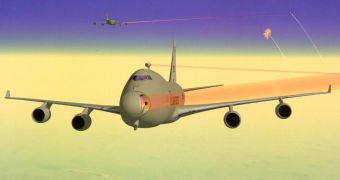After the Cold War, the U.S. did not build any more nuclear weapons and even plans to retire many of these weapons as part of its nuclear arsenal reductions under the Moscow Treaty on Strategic Offensive Reductions.
Instead, they concentrated on the only thing in the world that can stop an Intercontinental Ballistic Missile (ICBM) dead in its tracks: the Boeing YAL-1 Airborne Laser (ABL). This megawatt-class chemical oxygen iodine laser can shoot down nuclear missiles while in boost phase, the only effective way of stopping them.
Born during the Cold War, the idea was the only viable one to be produced for the US Army, specifically the U.S. Missile Command and the U.S. Air Force. This is no key chain laser, it's actually so big, that it will be fitted on a heavily modified Boeing 747-400F freighter.
Previously, in flight tests, it already proved its ability to shoot down missiles, although it wasn't actually aimed at a nuclear missile, only simulated test having been performed with the airborne laser. The only real tests were performed in the 80s, using an ancestor called the Airborne Laser Laboratory.
The task of shooting down ICBMs is highly complex and difficult, since they would limit the ability of the ABL to reach them, due to the distance and speed. The maximum range at which the laser would be effective against the liquid fueled ICBMs was calculated to be of 600 km (372 mi) and against the tougher solid fueled ones of only 300 km (186 mi).
That is really good, since it would give the ABL enough time to ready the plane and take off to intercept the missile, before it gets close to the US shoreline.
How does it actually work? Some scenarios circulating in the media suggest that the laser will burn through the missile, or even disintegrate it. While the nuclear warheads are fairly stable, the US Army doesn't want to risk an accidental explosion, that would not only kill the crew of the ABL, but also produce massive damage to any land area directly below the blast, which could happen to be an allied country.
Instead, the laser only heats the surface of the missile, to a point at which it causes structural failure, because of in flight stress forces, which would destabilize the missile and make it plunge without exploding.
Infrared sensors are used to detect the launch, and three lower power tracking lasers calculate the missile's course and speed, aimpoint, and measure atmospheric turbulence. Then, the laser fires for only a few seconds, 5 at most, from a turret mounted on the nose of the airplane, making the missile break up above the launch area.
Unfortunately, nothing can be done do destroy a nuclear missile in its terminal, or descending phase, which means that the airborne laser, while being an effective countermeasure, is not a definitive solution for the nuclear threat.

 14 DAY TRIAL //
14 DAY TRIAL //